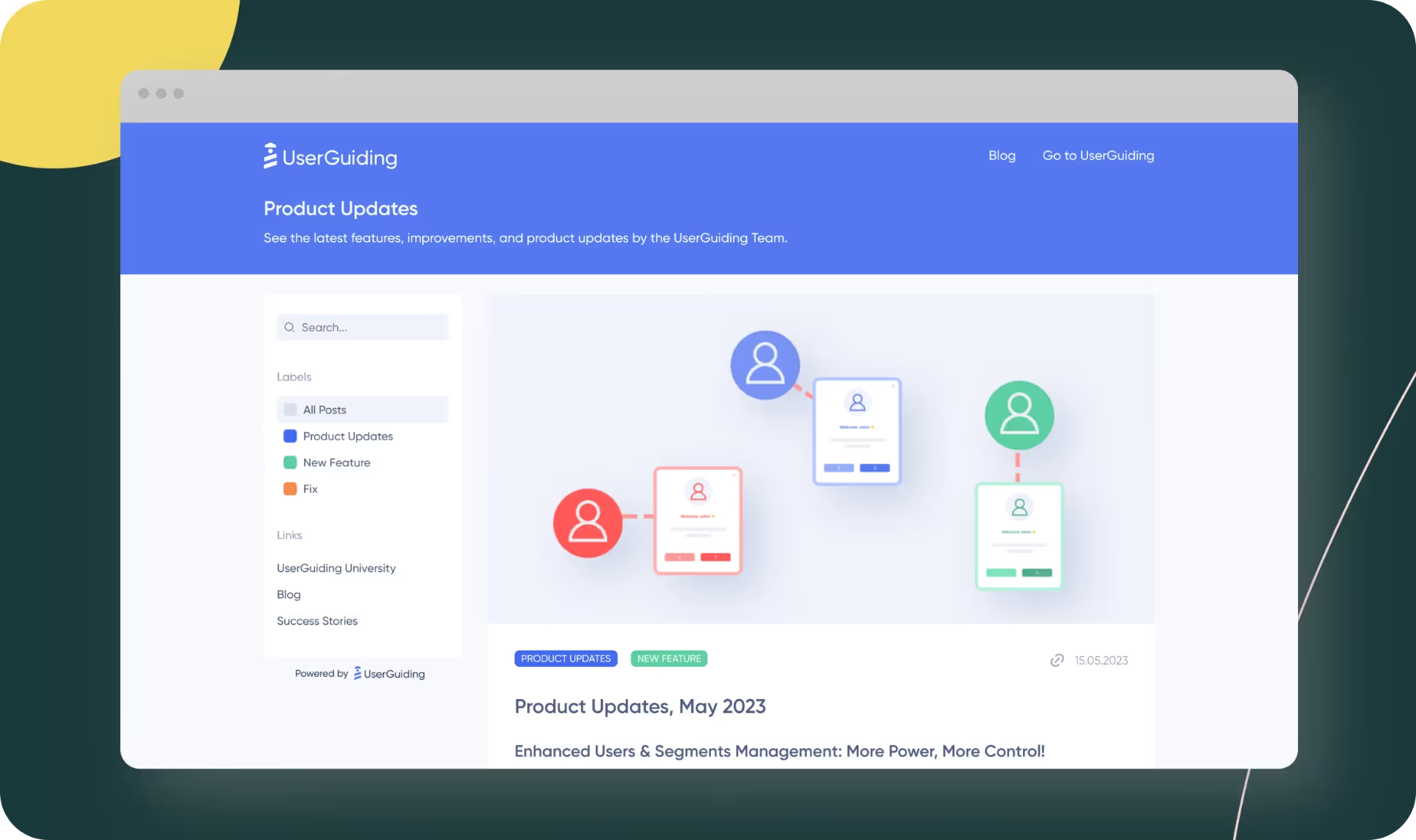

Almost ready to buy a Lou Assist plan, but not quite ready yet?
You need a product adoption tool, but you are suspecting that maybe Lou Assist is not the one?
On the eve of a big change, that's completely natural.
And to help you ease your suspicions, we've created a list of the best alternatives to Lou Assist you need to check out before the final decision.
Let's get right to it! ⬇️
TL;DR
- UserGuiding excels in no-code solutions for engagement and support.
- Appcues is ideal for onboarding and training but is more expensive.
- Stonly focuses on customer support and self-service.
- WalkMe provides extensive features for enterprise training, at a higher cost.
- Whatfix offers similar capabilities to WalkMe but is more affordable.
- Gainsight PX is suited for large enterprises needing in-depth analytics and customization.
- Intro.js and Shepherd Pro are open-source options for customizable and budget-friendly solutions.
What Lou Assist Does Well
Lou Assist is a pretty cool tool, and that's probably why you've considered it in the first place.
Among its most noteworthy benefits are:

1- Adequate key features for beginners
Lou Assist offers key features expected from your average user onboarding software.
With product tours, tooltips and hotspots, onboarding checklists, and announcement modals, Lou Assist provides users with an adequate set of user onboarding features for beginners.
2- Not one dimensional
Lou Assist is a user onboarding software aimed at smaller businesses, and its simplicity of features and pricing plans reflects this.
However, Lou does not allow this to stop the tool from having multiple use cases.
For example, though the main features are all user onboarding features, Lou adds in-app surveys to the mix and gives users a user feedback collection use case as well.
3- Satisfactory user segmentation and analytics feature
Though simple, Lou Assist offers an analytics dashboard with good visualization options.
The analytics feature helps track the performance of user onboarding elements and is sophisticated enough to improve in-app experiences for beginners.
In the same vein, Lou Assist's custom user segments also work well and help with personalized onboarding flows and in-app elements.
Drawbacks of Lou Assist
Much like any other digital adoption platform, Lou Assist has its drawbacks, the top 3 of which are:
1- No product analytics
Product analytics is a capability expected from more refined no-code solutions.
Though Lou Assist does offer user analytics to a degree, for users expecting to monitor product analytics in depth, Lou might be disappointing.
2- Limited sophisticated features
While Lou offers great product adoption and user onboarding features like product tours and onboarding checklists, it doesn't offer some staple features in the DAP industry.
For example, there is a lack of resource centers and, consequently, self-service support.
This makes Lou somewhat less attractive as a product adoption tool and confines it to being a user onboarding tool.
3- Price scaling issues
The thing with Lou's pricing is that it has a free plan and 3 other pricing plans as well.
And yet, it does not get functional enough until its Growth plan, which is the second most expensive.
Moreover, Lou doesn't offer customer support unless you are on the Enterprise plan, which is the most expensive one.
4- No updates on the horizon
Being a successful tool, Lou Assist has recently been acquired by Totango, which is great news for the tool, but not so great for its users.
As a telltale sign of acquisition, Lou has not been doing updates, and Lou's customers report that no customer support is available right now.
Now, if Lou's benefits seem little and the drawbacks are too close to your dealbreakers, we've got some alternatives for you 👇
8 Best Lou Assist Alternatives
1- UserGuiding - the all-around product adoption platform
- G2: ⭐4.6/5 (231 reviews)
- Capterra: ⭐️ 4.7/5 (51 reviews)
UserGuiding is a leading product adoption platform in the DAP industry, with a mission to be the one-stop hub product people need to optimize in-app experiences.

The tool is well known for its comprehensive no-code feature set, easy-to-use interface, fair and transparent pricing, and stellar customer support.
With its different use cases and extensive approach to digital adoption, UserGuiding is an important alternative to Lou Assist.
UserGuiding Use Cases
UserGuiding has a big collection of different use cases, but the most important ones as a product adoption tool are:
1. User onboarding & feature adoption
Founded as a user onboarding tool, UserGuiding offers product tours, interactive walkthroughs, tooltips and hotspots, user onboarding checklists, and more.

The same features come in handy for feature adoption as well.
Most importantly, all features within this use case were designed to help with personalized experiences and gamification.
Meaning, from onboarding new users to other in-app experiences, all are considered at UserGuiding.
2. In-app user engagement & announcements
UserGuiding uses announcement modals, interactive guides, tooltips, and hotspots to increase in-app engagement while informing users.

UserGuiding's changelog feature, Product Updates, directly contributes to this use case by offering an update hub where user communication is prioritized.

And lastly, the in-app surveys feature helps collect user feedback via in-app elements and takes in-app engagement to the next level.

It is also worth mentioning that both in-app surveys and Product Updates feature their own reports and analytics dashboards.
3. Self-service support & knowledge base
UserGuiding also offers features that contribute to promoting self-service support for end users.
With features like resource centers with help shortcuts and user guides embedded in checklists, it is easier for users to handle their problems before talking to a rep.
Moreover, with the knowledge base feature, you can create knowledge base articles, distribute them across your channels, and track how they are performing via an analytics dashboard.
Each knowledge base article can be monitored for actionable insights and better self-service support as well.
Pricing
UserGuiding’s pricing plans are based on the number of active users you have. When billed yearly:
- Starter Plan: Starting from $174/month.
- Growth Plan: Starting from $349/month.
- Enterprise Plan: Custom quote.
UserGuiding vs Lou Assist
The main difference between Lou and UserGuiding is the use cases.
While Lou Assist offers adequate tools for onboarding new users, UserGuiding takes a few steps forward. It helps strategize and take action for user engagement, in-app experiences, customer feedback, user training, in-app support, and more.
UserGuiding also offers product usage analytics, while Lou Assist analytics are more focused on insights from in-app elements.
Lou Assist's offer also lacks a resource center, which makes UserGuiding and the knowledge base feature more attractive. For those looking to improve self-service support, these are non-negotiable features.
In terms of pricing, Lou Assist offers a more affordable solution. However, it is important to note that for the same features, Lou Assist also needs to be upgraded, and the pricing gap becomes much smaller.
UserGuiding might be more pricey on paper, but for the full-capacity tool, they are similar in pricing.
So, if you want self-service support features like a resource center, more sophisticated onboarding flows, customer support no matter how much you pay, and overall a more scalable product, UserGuiding is the alternative for you.
2- Appcues - better for user onboarding
- G2: ⭐4.6/5 (305 reviews)
- Capterra: ⭐️ 4.8/5 (102 reviews)
Appcues is another product adoption platform that started out as a tool to assist end users with their onboarding journeys.

It is one of the pioneers of no-code solutions in DAP and offers a solid set of user onboarding features.
Being as established as it is in the digital adoption industry, the tool's starting price is around double that of Lou or UserGuiding.
But overall, Appcues is a pretty solid alternative to Lou for those with the budget for it.
Appcues Use Cases
Among the use cases for Appcues 3 are the most important:
1. User Onboarding and Training
Appcues product features like in-app messaging, product tours, and user onboarding checklists make the tool a fitting one for both user and customer onboarding.
2. Analytics and Optimization
Appcues has features like A/B testing and goal tracking, which, like in the case of UserGuiding, automatically makes it a better analytics tool than Lou.
3. User and Product Engagement
When Appcues' onboarding features are combined with its features like surveys and feedback collection, the tool becomes a user engagement unit.
Pricing
Appcues has recently started offering adjustable MAU ranges and a free trial.
The pricing plans currently look like this:
>2500 MAU
- Essential: $249/month
- Growth: $879/month
5K+ MAU
- Essential: $399/month
- Growth: $1149/month
10K+ MAU
- Essential: $499/month
- Growth: $1289/month
Appcues vs Lou Assist
Much like Lou Assist's lack of a resource center feature, Appcues does not offer one either, which makes both a bad pick for self-service support. Other features like product tours and other in-app experiences are present in both.
However, we should also note that Appcues is much more advanced and established, meaning there will be fewer bugs and glitches.
When it comes to analytics, Appcues is again more comprehensive with impact reports and custom events. Lou's analytics is adequate but not on par with Appcues.
The pricing is the main differentiator here, as Appcues is more than double the price.
The pricing is the main differentiator here, as Appcues is more than double the price, but they still offer customer support while Lou Assist currently offers no support after its acquisition by Totango.
So, if you want a more established user onboarding tool with advanced analytics and you're willing to pay more than Lou Assist or UserGuiding, Appcues might be the alternative for you.
3- Stonly - the customer support option
- G2: ⭐4.8/5 (123 reviews)
- Capterra: ⭐4.6/5 (57 reviews)
At its core, Stonly is a customer service platform that offers self-serve widgets and help centers.

But at one point, they decided to offer a use case for digital adoption as well, and now you can create product tours and other customer onboarding features.
Because it is not essentially a user onboarding platform, it might not seem like a top alternative to Lou.
But for those prioritizing the self-serve user experience, it is an important contender.
Stonly Use Cases
Stonly's main use cases are:
1. Support agent aid
Stonly's most essential feature, knowledge base, is a good tool for customer support teams to access information internally.
On top of this already smoother user experience, Stonly also offers their AI answers feature to better automize in-product experiences.
This helps support agents easily focus on customer satisfaction and deliver better in-app experiences.
2. Self-serve customer service
In the same way Stonly aids support agents, it aids your user base as well.
The entire feature set of Stonly is designed for this use case, and some features like checklists, interactive guides, and their resource center, the Widget, also support user onboarding experiences as well.
Pricing
Stonly does not offer public pricing, but they have a free trial.
It might be helpful to note that the last time Stonly had public pricing, the starting price was around $199 monthly.
Stonly vs Lou Assist
Comparing Stonly and Lou Assist is not easy since they are essentially different products in different categories.
However, with Stonly's user onboarding experience offer, we can try.
In terms of features, Stonly comes off strong since it has pretty established features. Yet, if the scope is only digital adoption features, Lou Asisst has a more powerful feature set.
When it comes to ease of use, both tools are strong. However, customer support is a matter of ease of use as well.
Though Stonly does not offer priority support to just anyone, they at least do offer support. Lou Assist offers support only after its most expensive plan.
Though Stonly does not offer priority support to just anyone, they at least do offer support. Lou Assist currently offers no customer support after being acquired by Totango.
And in terms of pricing, Lou is, once again, ahead. Lou Assist is a more affordable product and unless you want customer service use cases primarily, Stonly might be expensive.
4- WalkMe - enterprise-level employee training
- G2: ⭐4.5/5 (407 reviews)
- Capterra: ⭐️ 4.4/5 (62 reviews)
WalkMe is another digital adoption platform, similar to Appcues in market presence. The tool is designed to help enterprise-level businesses with employee onboarding and training.

WalkMe is naturally a complex tool due to its user base and the learning curve can get rather steep and technical.
The platform is also quite exclusive, given that it offers all sorts of onboarding platform features and, on top of that, product analytics.
WalkMe Use Cases
1. Employee Onboarding & Training
WalkMe excels in user onboarding, using features such as walk-throughs, smart tips, and task lists to create effective onboarding experiences.
These are particularly effective for onboarding employees but can also be used for new user onboarding or customer experience as well.
2. Analytics & Feedback Collection
WalkMe also leverages its insights, user sentiment analysis, and other product analytics features to provide robust analytics capabilities.
The tool's feedback collection use case is also powerful since it sheds light on data with meaningful insights.
3. Productivity Optimization
Similar to employee onboarding, WalkMe's features like shoutouts, search functionality, and automation tools boost productivity.
These tools are also beneficial for user onboarding and engagement.
Pricing
WalkMe does not have a free version or free trial, they are pretty strict with the content they share publicly as well, including their pricing.
However, WalkMe is known for its annual contracts that are rarely below several tens of thousands.
WalkMe vs Lou Assist
WalkMe and Lou differ not only in their main use case but also in their pricing.
WalkMe offers a whole suite of tools and features most digital adoption platforms cannot afford to offer, including product tours, resource centers, user feedback features, and product analytics.
Lou Assist does not offer some of these features, but the fact that WalkMe is best for those looking to onboard employees still makes Lou viable for user onboarding use cases.
WalkMe has a big list of integrations as well. However, Lou Assist is both easy to use and implement.
Lastly, WalkMe is one of the most expensive product adoption platforms, giving a pricing advantage to Lou with a starting price of $79 monthly.
So, if you need an enterprise-level employee onboarding solution, WalkMe is a good competitor and alternative to Lou.
5- Whatfix - affordable employee onboarding
- G2: ⭐4.6/5 (329 reviews)
- Capterra: ⭐️ 4.6/5 (77 reviews)
Whatfix is a digital adoption platform that is basically exactly the same as WalkMe except for its slightly more affordable pricing.

Whatfix also has a main use case of employee onboarding and training, and it has a very thorough set of features most user onboarding platforms have.
And for those who've just realized they need an employee onboarding solution instead of a user onboarding one, it can be a great alternative to Lou and WalkMe.
Whatfix Use Cases
As we've mentioned just now, Whatfix is very similar to WalkMe, including its use cases:
1. User onboarding and employee training
Whatfix offers both user onboarding and employee training powered by features like interactive product walkthroughs, task lists, and self-help menus, aka resource centers.
2. Analytics
Similar to WalkMe, Whatfix boasts a product analytics feature that allows users to check product usage analytics, as well as in-product experiences with onboarding elements.
With different types of reports and tracking abilities, analytics becomes a main use case for Whatfix.
3. User Engagement & Self-Serve Help
With in-app messaging and Whatfix's Self Help widgets, the tool not only offers user engagement options but also promotes self-serve.
Pricing
Like WalkMe and Stonly, Whatfix does not share its pricing options publicly. There is also no free plan or free trial.
However, user reviews show that the average amount is around $1000/month, making Whatfix one of the more expensive solutions.
Whatfix vs Lou Assist
Comparing Whatfix and Lou Assist is also very similar to comparing WalkMe and Lou Assist: Whatfix offers a vast feature set, better analytics, resource centers, more user feedback options, and a better product experience.
But Whatfix also has very expensive pricing, a steep learning curve requiring technical knowledge, and an employee training use case primarily.
So the decision once again boils down to whether you need an employee onboarding solution or a user onboarding solution and how much exactly you can pay for it.
If you need employee training software that is slightly more affordable than WalkMe, Whatfix is the alternative you need.
6- Gainsight PX - enterprise-level product analytics
- G2: ⭐4.4/5 (226 reviews)
- Capterra: ⭐️ 4.0/5 (7 reviews)
Gainsight PX is Gainsight's product experience solution. Though it is not directly a user onboarding tool, its capabilities could make it a good alternative to Lou.

Gainsight offers powerful product and user analytics and product engagement features.
Paired with the other Gainsight solutions, it really becomes a whole digital customer experience hub.
Gainsight PX Use Cases
1. User Onboarding
With interactive walkthroughs, tooltips, and in-app guides, Gainsight offers a pretty good user onboarding use case.
The tool also enables custom user segments for personalized onboarding and experiences.
2. Feature Adoption
Users can make great use of Gainisght PX by analyzing user behavior with analytics and using in-app messages and guides to help users navigate and understand new features better.
3. User Feedback Collection
Gainsight PX offers in-app surveys and sentiment analysis for user feedback collection and data-driven decision-making.
Pricing
Gainsight does not offer public pricing for its product experience solution, but there is a free trial.
Though not confirmed, reviewers of the tool claim that Gainsight charges $500 per user per month, which would make the product potentially even more expensive than WalkMe.
Gainsight PX vs Lou Assist
Though both Gainisght and Lou offer valuable tools for onboarding and engagement, it is also true that they address different segments of the market.
Still, if you're more inclined to go with a product experience tool, Gainsight offers extensive segmentation and customization options. It also has a wider feature set and better analytics.
On the other hand, Gainsight PX is much more expensive than Lou's starting price, and there is a steep learning curve involved.
So, if you're willing to go with a product experiences tool rather than prioritizing user onboarding experiences, Gainsight PX might be the alternative for you.
7- Intro.js - the open-source library for devs
Intro.js is an open-source library with a simple proposition: creating product walkthroughs for websites.

Being the kind of tool it is, Intro.js requires coding skills and technical knowledge if it is to be used to its full potential.
Meaning, if you have a developer whose time you can spare, you can create tooltips to highlight new features or create product tours for a web page.
The tool also naturally has better customization options.
Intro.js Use Cases
As we've just said, Intro.js is a very, very simple solution that can be used for onboarding and some level of product engagement.
Some of its functionalities include:
- Step-by-Step Guides
- Customizable Tooltips
- JavaScript API
- Cross-Browser Compatibility
Pricing
Unless you are using it for commercial reasons, and I expect you will, Intro.js is free.
But even when you want to use it commercially, it comes at a price that couldn't hurt your budget:
- Starter: $9.99/lifetime
- Business: $49.99/lifetime
- Premium: $299.99/lifetime
Intro.js vs Lou Assist
If you need a user onboarding platform, Lou Assist is a better tool in all ways, including features, analytics, user experience, and customer support.
But if you need to watch your budget and you have the time and coding skills to use Intro.js, it is also a valid option as a user onboarding solution.
8- Shepherd Pro - a more defined code library
Lastly, Shepherd Pro is the advanced version of the open-source library Shepherd.js.

Shepherd.js was a very similar tool to Intro.js, both being almost completely free open-source libraries.
However, now that it offers some level of analytics and other features, Shepherd Pro might have become a more feasible option than before.
Shepherd Pro Use Cases
As I've just explained, Shepherd still is a simple product. Its main use case is user onboarding, but now it is backed up by simple analytics as well.
Shepherd Pro can also be used with React, Ember, Angular, Vue.js, ES Modules, or just Javascript now.
Pricing
The Shepherd library on GitHub offers a free option for those who do not require the advanced features of the Pro version.
Additionally, a free version of Shepherd Pro is also available.
- Alpha: Free access with unlimited features and integrations, including additional support.
- Enterprise: Custom pricing featuring premium service and priority support.
Shepherd Pro vs Lou Assist
Similar to the Intro.js case, Lou Assist is more powerful when it comes to features, analytics, segmentation, ease of use, and customer support.
However, Shepherd Pro allows for more customization and is definitely a lot cheaper.
Wrapping Up
As we conclude, here’s a concise summary of the best alternatives to Lou Assist.
UserGuiding is ideal for companies seeking a comprehensive no-code solution for user engagement, in-app experiences, and customer self-service with transparent pricing.
Appcues is best for user onboarding and training, offering advanced analytics and engagement features at double the price.
Stonly is good for businesses prioritizing customer support and self-serve help with less focus on onboarding.
WalkMe and Whatfix are excellent for enterprise-level employee training and onboarding. WalkMe offers extensive features and analytics at a higher cost, while Whatfix provides similar capabilities that are more affordable.
Gainsight PX is suitable for large enterprises needing in-depth analytics and extensive customization.
Intro.js and Shepherd Pro are open-source options for those with coding skills. Intro.js is great for creating customizable product walkthroughs on a budget, while Shepherd Pro offers advanced features, good customization, and simple analytics at a low cost.
Each alternative offers unique strengths for different aspects of product adoption and user engagement. Now, it is up to you to pick one.
Good luck in advance 🍀

















.svg)
.svg)
.svg)
.svg)
.svg)

.svg)
.svg)












.svg)
.svg)




.png)

















